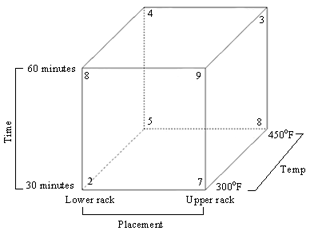Definition
In the analysis of a 2-level full or fractional factorial design, the combinations of levels of any three Factors at a time can be represented in the form of a cube whose vertices correspond to the either the 'High' or the 'Low' level for each of the three Factors. The response value, either observed or predicted, is printed alongside each vertex (combination).
Examples

The cube shown plots the average Taste score for baked bread at each point in the cube defined by the three factors Placement in Oven (Low=lower rack, High=upper rack), Baking Time (Low=30 minutes, High=60 minutes) and Oven Temperature (Low=300oF, High=450oF).
Thus, the taste score at the vertex corresponding to the combination (lower rack, 30 minutes, 300oF) is 2. Similarly, the response corresponding to each of the vertices (lower rack, 60 minutes, 300oF) and (upper rack, 30 minutes, 450oF) is 8, and so on.
In order to maximize the taste score, the combination (upper rack, 60 minutes, 300oF) gives the optimum response value of 9.
Application
The cube plot is a graphical presentation of the response means at the different combinations of factor levels.
